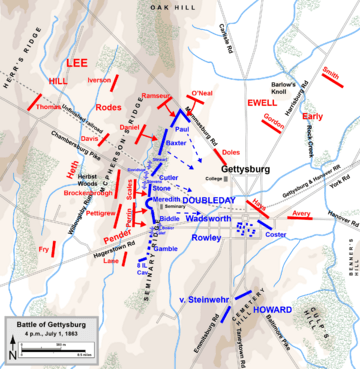Seminary Ridge facts for kids
Quick facts for kids Seminary Ridge |
|
|---|---|

July 1, 1863, at 4:00 p.m.: Union troops (blue) occupied Seminary Ridge.
|
|
| Highest point | |
| Peak | driveway entrance (SW Confederate Av) |
| Elevation | 581.60 ft (177.27 m) |
| Naming | |
| Etymology | Lutheran Theological Seminary |
| Geography | |
| Location | Triple watershed point: Pitzer's Run (west) & both Stevens Creek/Plum Run (east) |
| Country | United States |
| Range coordinates | 39°15′13″N 77°15′13″W / 39.25361°N 77.25361°W |
| Biome | Northern Piedmont ecoregion |
| Geology | |
| Type of rock | Gettysburg-Newark Lowlands and Rossville Diabase dike (50 feet thick) |
Seminary Ridge is a long, narrow hill in Gettysburg, Pennsylvania. It played a very important role in the Battle of Gettysburg in July 1863 during the American Civil War (1861–1865). This ridge was also used for military training during World War II (1941–1945).
Contents
What is Seminary Ridge?
Seminary Ridge is a natural high point that helps divide water flow. On its west side, water flows into Marsh Creek. On its east side, water flows into Rock Creek. These two creeks eventually join to form the Monocacy River.
The ridge starts near Oak Ridge in the north. It then splits into two parts: McPherson Ridge and Seminary Ridge. Seminary Ridge continues south, passing through areas like Pitzer Woods and the Gettysburg National Park.
Key Spots on the Ridge
Many important places are found along Seminary Ridge. These include:
- The historic Gettysburg Armory.
- Several wooded areas like Schultz Woods, Spangler Woods, and Pitzer Woods.
- The McMillan Woods Youth Campground.
- The 1895 Longstreet Tower, which offers great views of the area.
- The Eisenhower National Historic Site, which was once President Dwight D. Eisenhower's farm.
Roads like Seminary Ridge Avenue and West Confederate Avenue follow the ridge. They lead to many monuments that remember the battle, including the large Virginia Monument.
South Seminary Ridge
South Seminary Ridge is the part of the ridge located south of a small stream called Pitzer Run. This area includes Pitzer Woods and extends past the Longstreet Tower. It reaches the Emmitsburg Road and the Alabama Memorial, which marks the southernmost point of the Confederate battle line. This southern part of the ridge is also known as Warfield Ridge.
History of Seminary Ridge
The area around Seminary Ridge has a long history. In 1761, a tavern owned by Samuel Gettys was built nearby. This was before the Chambersburg Pike road was built across the ridge around 1812.
The Gettysburg Theological Seminary was founded on the ridge on August 1, 1826. Later, in 1832, its first building, Old Dorm (now Schmucker Hall), was built. Gettysburg College also started nearby on the east side of the ridge.
In 1834, a building near the seminary was constructed. This building later became the headquarters for Confederate General Robert E. Lee during the Battle of Gettysburg.
The Civil War and After
Seminary Ridge was a key location during the Battle of Gettysburg.
- July 1, 1863: Heavy fighting took place here.
- July 2, 1863: There was also an engagement in Pitzer Woods.
General Robert E. Lee set up his headquarters on the ridge. The ridge then became the main battle line for the Confederate forces on July 2 and 3. From here, they launched attacks against the Union Army on Cemetery Ridge.
On July 3, during the famous Pickett's Charge, many Confederate soldiers were killed or wounded on Seminary Ridge. This happened because of heavy artillery fire from the Union side before the charge. The seminary's Old Dorm was used as a hospital after the battle.
After the war, the Longstreet Tower was built on the ridge in 1895. West Confederate Avenue was built around 1900 to help tourists visit the battle monuments. Sharpshooters Avenue was added later for access to a monument in Pitzer Woods.
In 1918, military training camps, like Camp Colt, were set up between Seminary and Cemetery ridges.
The Civilian Conservation Corps
The Civilian Conservation Corps (CCC) was a program during the Great Depression. They built a camp on Seminary Ridge in 1938 for Civil War veterans attending the 75th Anniversary of the Battle of Gettysburg. The CCC also worked on landscaping the battlefield until 1941.
There were two CCC camps on the ridge:
- Camp NP-2: Opened in McMillan Woods in 1934 and closed in 1941.
- Camp NP-1: Located in Pitzer Woods from 1935 to 1937. This camp focused on planting trees.
World War II and Modern Times
During World War II (1943-1944), Camp Sharpe was set up at the former Pitzer Woods CCC camp. Here, soldiers were trained for special operations. Next to Camp Sharpe, a prisoner-of-war (POW) camp was located in McMillan Woods from 1944 to 1946.
After President Eisenhower bought his farm nearby in 1950, the Secret Service used the Longstreet Tower to watch for tourists. In the 1960s, an amphitheater was built in Pitzer Woods.
The Adams County Historical Society moved to the seminary's Old Dorm in 1961. Old Dorm was added to the National Register of Historic Places in 1974.
In 1982, the Tennessee State Memorial was dedicated on West Confederate Avenue. A memorial to Confederate General James Longstreet was placed in Pitzer Woods in 1998.


